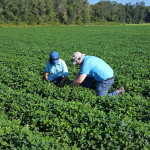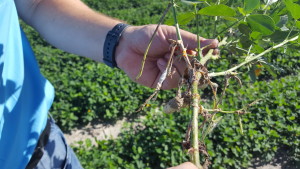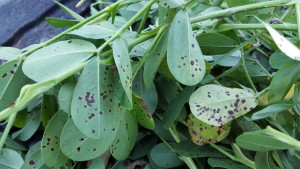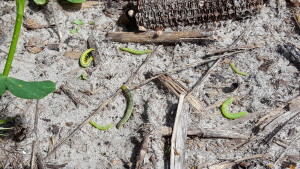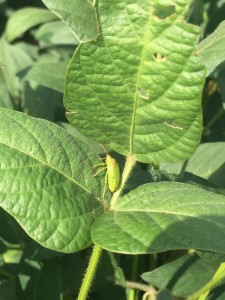We were fortunate across north Florida to receive crop saving rains at the end of July and through August. There probably couldn’t have been a more perfect timing for pegging and pod fill of peanuts, and setting pods in soybeans. However, we are into our typical problems of August with plant disease and insects. If I can give one word of advice, it is to get out into the fields and investigate. If you can’t go, send your spouse, friend, neighbor, child. I don’t know, but pay attention. Crops in North Florida appear to be deteriorating rapidly in many instances from a wide array of culprits.From a pathology standpoint, white mold is prevalent in peanuts following heavy rainfall and high temperatures.
I am most concerned about later planted peanuts that are pegging down and we see disease infesting these new pegs. Some fields will struggle to make a crop under these conditions without serious effort to control. In some cases, there was no early crop to speak of due to prolonged dryness, and the late crop is struggling to set. I am seeing additional challenges from late leaf spot, and this looks like it will be another tough August and September to keep peanuts from defoliating under intense disease pressure. Digging is just beginning locally and those peanuts are obviously safe. However it is the peanuts that need about 40-50 more days to harvest and late leaf spot is ramping up, that are a serious concern. Unfortunately we see this in peanuts with both a bare bones spray program, and what we might call a Cadillac program. It doesn’t appear the Cadillac will coast to the finish any easier. I encourage producers to look at their crops closely and develop a strategy depending on anticipated harvest date.
The insect situation has been even more fun, as folks are “asleep at the wheel” and returning to find severe defoliation and a spectrum including soybean loopers (tough to control), and velvetbean caterpillar (easy to control). These are both prevalent in soybeans and peanuts. Accurate identification is critical for appropriate control. High levels of stinkbugs are also common in the soybeans. We continue to find a high number of Red-Banded stinkbugs in local bean fields. These are reportedly tougher to control with the available products, and deliver higher levels of damage on seed quality.
In a nut-shell; what has been a relatively quiet season just got loud. It is important to get out and look at these fields and develop appropriate strategies to successfully meet our yield potential. The included photos were all obtained in local fields this week; this is a wide array of issues that are minor in nature with attention, and major in nature given lack of attention. Please pay attention out there. “Go Fertilize.”

